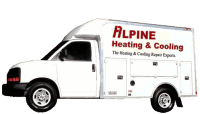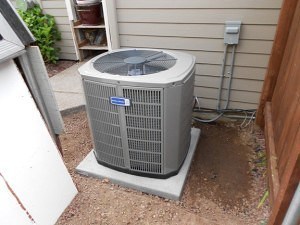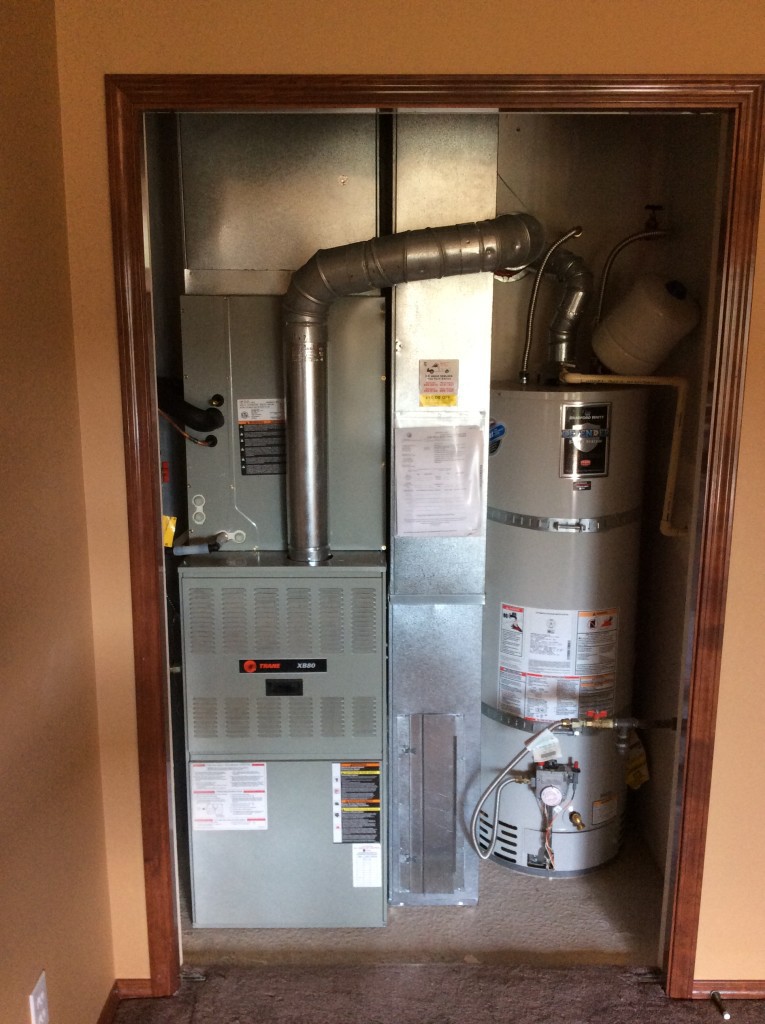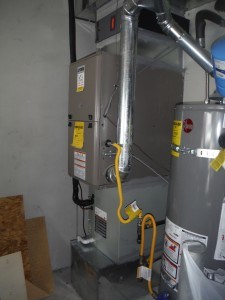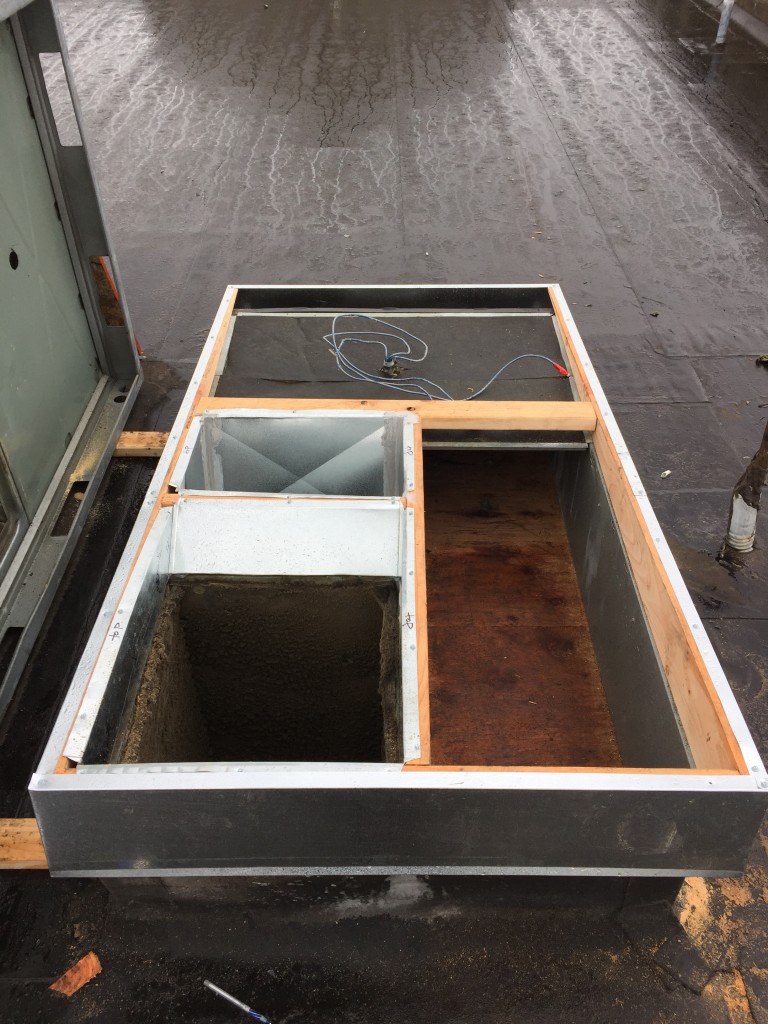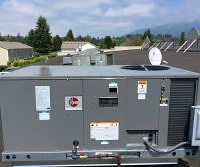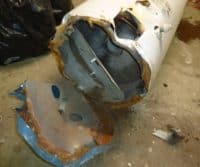
It’s Never a Good Time for Water Heater Replacement
Nobody wants their water heater to fail, but every one will fail unless replaced first. Most people are taken by surprise when they need water heater replacement, but it doesn’t have to be that way. By paying attention to the right details, you can avoid the unpleasantness of being without hot water longer than necessary, having an unexpected expense, and possibly avoid significant flood damage to your home. What are the signs of a failing water heater, and when should you look for them?
Is Your Water Heater Past its Prime?
Because water heaters are designed to have a limited useful lifespan, it is important to know when your unit was installed. You can often find the manufacture date on the rating label (or, on older models, decoding the serial number may tell you the manufacture date), but that may not be an accurate representation of how long the unit has been in service.
If you had the water heater put in, you might still have the receipt for the work that was done. Many companies will also put a sticker on the unit when they install it that may includes the installation date. Or, you might be able to give them a call and find out when they installed the water heater.
Once you know how long the water heater has been in service, you can take the appropriate steps to evaluate it. The average lifespan of a water heater is a subject of great debate, but if the unit has been in service at least six years, you should at least inspect it yourself, and may want to have it professionally inspected. If it has been in service more than ten years, look extra carefully for signs of trouble.
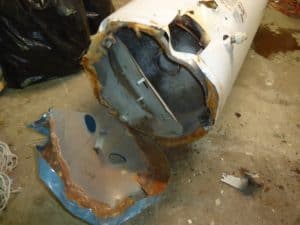
This water heater was leaking for some time.
What Problems Should I Look For?
- Noticeably less available hot water or longer recovery time. If you can remember when it was no problem for everyone in the family to take showers one after the other, but now you’re all fighting to take the first shower, you might have an issue with a heater element, dip tube, thermostat, or excessive sediment buildup.
- Visible rust on and/or moisture on or around your water heater. If you see rust and water on the outside or surrounding your unit, it could be nothing, but that isn’t likely. The exterior of your water heater should be clean and dry. If the tank is rusting and water has begun seeping out, a full-blown failure that could include flood damage is impending.
- More than one service call on the unit. Repeated stop-gap measures are often a sign that a water heater is nearing the end of its life. Like an old car, the cost of repeated repairs can often exceed replacement cost while never really solving the problem.
- Metallic smell or taste to your hot water. This could be a sign that the water tank itself is breaking down and will soon fail. Best to have a professional check it out more closely in this case.
- Rumbling and other noise coming from the unit. Water heaters should be nearly silent. You might hear the sound of water simmering or the gas flame burning, but rumbling, banging, or cracking sounds are not good. If you notice any of these when your water heater is in operation, call a professional.
Is There any way to Avoid Failure?
While nothing mechanical lasts forever, there are a few actions you can take to ward off premature failure. Modern water heaters are designed to require little or no maintenance, but the following will make sure you are familiar with the condition of your water heater and give it every advantage.
- Drain the water heater every six months to remove sediment. This will also increase efficiency.
- Test the pressure relief (T&P) valve by lifting the valve’s handle and letting it snap back. This should release a burst of water into the overflow drainpipe, then the flow should stop completely. If it doesn’t, install a new valve.
- Lower the temperature setting on the thermostat(s) to 120 degrees Fahrenheit. This minimizes damage to the tank caused by overheating and protects your home’s occupants from scalding.
Use caution when working with electricity, gas, and hot water. If you are unsure of how to safely do any of the above steps, call a professional for help. Alpine Heating and Cooling replaces and installs tank-type and tankless water heaters, performs maintenance on all brands, and carries out warranty repairs on many popular brands. If you think you might want to replace your tank-type water heater with a new, more efficient tankless water heater, check out our guide to choosing between tank-type and tankless.
Water heater replacement is nobody’s idea of fun, but we do love our work! If you have any questions about your water heater, give us a call. We can come out and give you a free estimate for any needed work. You can reach us at 360-755-5146 or 360-293-6210. We look forward to helping you!

A healthy water heater is clean and dry with no signs of rust.
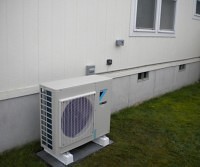
The Best Is Not the Same for Everyone
While we might want to know which brand of air conditioner is the best overall, the first question might be which type is the best air conditioner for Skagit county. Modern manufacturing processes are excellent. Top brands are competing at a high level of reliability. Efficacy, though, is determined by application as well as design.
The majority of the cooling season in the Skagit Valley features low relative humidity. While it may be uncomfortably warm in your home, it is not usually also uncomfortably humid. An air conditioning unit that includes a dehumidifier may not be the most efficient choice.
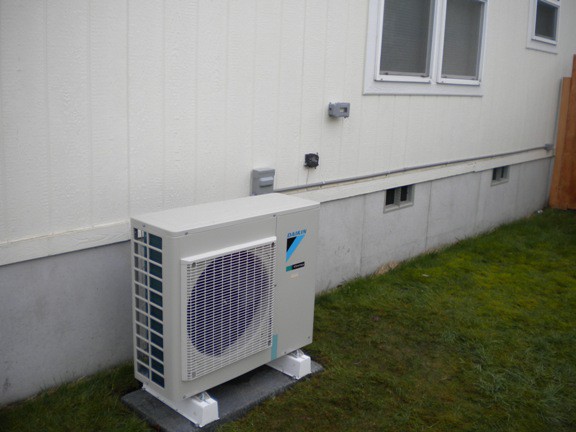
Unlike the huge condenser units of the past, a ductless mini split won’t dominate your yard or ruin the look of your home.
How to Reduce the Load on Your HVAC – and Your Wallet
Before we look at what type of air conditioner performs the best where we live, let’s refresh ourselves on what we can do to make any air conditioner, including the one you might have now, perform better.
- Seal leaky ducts or re-route old, convoluted airways. Be sure ducts are free of obstructions.
- Ensure that the condenser (the part outside) has plenty of room to breathe – cut bushes back and don’t crowd it with objects or obstructions to airflow.
- Consider adding awnings to south-facing windows to reduce solar heating of your home.
- Use heat-generating appliances such as dryers and ovens during cooler parts of the day.
- Cool only the spaces you are using at any given time.
Avoiding the losses associated with leaky, dirty, or poorly-sized or -routed ducts while also cooling only the spaces you are using is easy – with a ductless mini split.

Your Condenser Unit Needs Ample Airflow to Operate Efficiently
The Best Air Conditioner for Skagit County is American Standard
I mentioned earlier that the top brands are all competing at a high level of reliability. Still, I prefer to sell and install American Standard over any other brand. I will install a less expensive piece of equipment IF you are on a tight budget, or an American Standard will not fit with your existing system. American Standard is a better built piece of equipment. That’s just not my experience talking, but also consumer reports over the last six or so years.
Even the best piece of equipment, if badly installed, will perform poorly and fail early. That’s why Alpine Heating and Cooling guarantees our labor for life. Installing an American Standard Ductless Mini Split system gives us a great sense of satisfaction. We know that you will be comfortable and happy with your new system for years to come.
For many of our customers, the best air conditioner for Skagit county is an American Standard Ductless Mini Split. The best is not the same for everyone, though. We are happy to guide you in your decision. Which HVAC setup is right for your home, family, and budget is personal. Give us a call today to see how we can help you spend less and be more comfortable no matter the weather. We can be reached at 360-755-5146 or 360-293-6210 and are excited to help you!
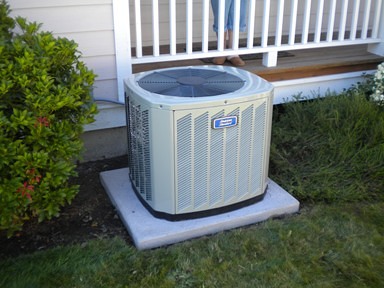
Clean, High-Quality Installations Are Our Hallmark
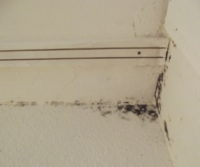
Black Mold Has Significant Negative Health Implications
While the term “toxic mold” isn’t exactly accurate, many molds, including so-called “black mold,” (Stachybotrys spp.) produce toxins that negatively impact human health.
According to the Centers for Disease Control:
In 2004 the Institute of Medicine (IOM) found there was sufficient evidence to link indoor exposure to mold with upper respiratory tract symptoms, cough, and wheeze in otherwise healthy people; with asthma symptoms in people with asthma; and with hypersensitivity pneumonitis in individuals susceptible to that immune-mediated condition. The IOM also found limited or suggestive evidence linking indoor mold exposure and respiratory illness in otherwise healthy children.
Molds grow from spores, which are ubiquitous in our indoor and outdoor environments and become active when conditions are right. Persistent moisture is the biggest factor that causes mold to grow and produce more spores and harmful toxins. Since the proliferation of Stachybotrys depends so strongly on moisture, the best place to begin is to figure out where excess moisture in our homes comes from and how we can mitigate its accumulation.
Where Does Problem Moisture Come From?
Any water-using appliance or fixture, especially ones using or producing hot water, are strong sources of indoor moisture.
- Showers (run the fan!)
- Washing machines
- Dishwashers
- Sinks and tubs
- Unvented combustion sources (gas stoves and space heaters, typically)
- Steam irons
Cooking, too, releases moisture into the air, as does human respiration (moisture is expelled from the lungs and through the skin). When you go outside on a cold day and “see your breath,” you are actually seeing the moisture you exhale every time your lungs fill and empty. If you and your whole family are snug in your warm house with the windows and doors shut all winter, you can see how that might become a problem!
The World Health Organization (WHO) identifies eleven common sources of moisture-related issues in buildings (see the entire list here on page 54). A complete discussion of them all is beyond the scope of this article, but we will touch on those related to heating and cooling and how they can be mitigated.
The following are excerpted from that list:
- Plumbing leaks and spills, perhaps resulting from improper design, installation,
operation or maintenance (e.g. failure to inspect and repair plumbing
leaks) - Infiltration of warm, moist outside air through cracks and holes in the enclosure
during warm, humid weather – which can cause condensation on materials
that are cooler, because they are part of the air-conditioning system – have
been cooled by air-conditioned indoor air or are in cool basements or crawl
spaces - Exfiltration of warm, moist indoor air through cracks and holes in the enclosure
during cold weather, which can cause condensation in wall and ceiling
cavities and attic spaces - Intentional or accidental vapor barriers in the wrong place, which can lead to
condensation in the building enclosure - Unvented or poorly vented sources, such as swimming pools, spas, aquariums,
dishwashers, combustion devices, kitchens and baths, from which water
may condense in the building enclosure or, if indoor humidity levels are high
enough, on materials in the space itself (e.g. ceilings, walls, furniture, cold water
pipes or air-conditioning air supply diffusers) - Insufficient dehumidification by HVAC systems,
which may result in levels of interior humidity that are high enough to
cause mould to grow on furniture, walls, ceilings or air-conditioning supply
diffusers - Poor condensate drainage due to heating, ventilation and air-conditioning
system deficiencies; condensation from cooling coils may overflow drain pans
or leak from condensate drain lines
Sources of Excess Moisture Vary by Season
In Skagit county, we have four wonderful seasons. Each is defined by a typical air humidity level and temperature range. Our climate determines how we condition our spaces for both our comfort and health in each season. The winter is typically cold and moist, with temperate summers that can vary from dry to humid depending on the prevailing weather pattern.
Many of the conditions experienced in Skagit county can quickly cause an excess of moisture and mold buildup in the home. Here are some tips to avoid mold buildup.
During (or before!) the heating season:
- Install double pane windows (at minimum) or shrink-wrap plastic indoor window covers
- Ensure sufficient indoor/outdoor (fresh) air changes – run fans, open a window or two, or install an ERV/HRV (energy/heat recovery ventilators)
- Maintain enough heat in the space (minimum temperature) to overcome the condensing effect of unabated drafts and cold air leaks
During the cooling season:
- Use a standalone dehumidifier when indoor humidity exceeds 50%
- Ensure careful insulation and encapsulation of cooling lines where they pass through building materials
- Properly installed and intact (functioning) vapor barrier
- Maintain the temperature in a small range rather than large warming and cooling cycles
- Keep condensate drains clear – make sure condensate goes to a sewer drain or outside and away from the building and foundation
- Use a toilet tank insulator kit or plumb warm water (with a mixing valve) to your toilet tank
All seasons:
- Avoid large swings in indoor temperature that alter the ability of indoor air to hold moisture
- Keep indoor humidity under 50% (use an indoor humidity meter (like this one, under $10) to monitor it
- Make sure that you home has good overall insulation
- Be sure you have a properly designed, installed, and intact vapor barrier
- Insulate all exposed or uninsulated cold water pipes – condensation or freeze (and subsequent leak) risk
I’m Feeling Overwhelmed! Help!
This (partial) list of ways that moisture can build up and contribute to harmful black mold growth can be a bit daunting. Sometimes, I feel the same way when I’m struggling with my computer and it just won’t do what I need it to do! I have found the solution, and I think it will help you, too: call a professional.
Alpine Heating and Cooling is not a mold remediation business, but we can come out and take a look at your heating and air conditioning equipment, which is a common source of moisture problems. We’ll make sure it’s properly installed, functioning at top efficiency, and that drains are clear, and lines are insulated. You’ll be ready for whatever mother nature throws at us here in Skagit county.
Give us call or send us an email – we’d love to hear from you.
For even more reading, check out this fantastic publication from the University of Wisconsin Cooperative Extension called, “Winter Home Moisture Problems.”
Is Your Money Flying out the Window?
Most folks don’t enjoy paying more than they need to, or paying for something they aren’t getting. When it comes to heating (and cooling) your home, you may be doing exactly that. How can you find out? A home energy assessment can tell you where the energy you’re paying for is going. Efficient energy use is smart money management
Your Personal Comfort – the True Test
A more personal test is to compare your comfort level in your home with the comfort level of your wallet or pocketbook. Are you paying more than you’d like to, but you still aren’t warm in winter and cool in summer? While this sacrifice may have been necessary in the past, today’s new technologies and heating/cooling systems can pay for themselves with savings in a few years, then keep on saving you money for years to come. There are even rebates and incentives to help you out.

Efficient Energy Use Begins With a Tight Building Envelope
As in the video above, it’s important to stop your expensive heated or cooled air from leaving for as long as possible. A tight building envelope is a must. Once you’ve checked your insulation and sealed up the windows it’s time to address another area of loss – the equipment used to heat and cool your home.
Here is a quick overview of some of the systems and technologies Alpine Heating and Cooling installs and how they can save you money.
Heat Pumps
A heat pump is a device that transfers heat from a colder area to a hotter area(“against the gradient”) by using mechanical energy, as in a refrigerator. While that may not sound like it could heat your home, the fact is there is heat energy all around us waiting to be harvested. A heat pump can move this heat from the air (air source heat pump) or the ground (ground source heat pump) into your home. Think of it like a refrigerator in reverse.
Here is a terrific, short video of an air-source heat pump showing operation in both summer (air conditioning) and winter (heating) modes.
Natural Gas Furnace
A natural gas furnace is a popular and smart choice for home heating in the Skagit Valley. Natural gas is available to most homes, is clean burning, and modern gas furnaces can achieve as high as 98.5 efficiency ratings while lasting for 15-30 years with regular maintenance.¹
Also according to energy.gov, between 2007 and 2012 the average U.S. household spent $700 annually to heat with natural gas versus $1700 per year to heat with oil. A new, high-efficiency gas furnace can save you money, especially if you are moving from an older, lower-efficiency oil furnace.
Ductless Mini Split
A Ductless Mini Split heat pump system can decrease your energy bill in several ways.
- Ducting can lose 10-40% of the heat or cool they carry before it reaches you, even more if there are serious breaks or leaks, which often go unnoticed in attics and crawlspaces. Ditch the ducts, ditch the loss.
- Mini splits can be used “zonally” to heat and cool individual rooms or floors. You don’t need to heat or cool your entire house to the same degree if you aren’t using most of it.
- The modern heating and cooling technologies used in ductless mini splits are more efficient than their older counterparts.
Programmable Thermostats
Any on-demand heating system including furnaces, heat pumps, and mini-splits can benefit from the proper use of a programmable thermostat. A programmable thermostat can help save you money when you’re away or asleep so that there’s more left over to keep you warm or cool when you’re home and awake.
By using “setbacks” (cooler settings in the winter and warmer settings in the summer) for times when you don’t need the full effect of heat or air conditioning, you can see a reduction in your utility bill with no change in your comfort level. Your programmable thermostat can turn your heat down when you leave for work or go to sleep and turn it back up just before you wake or return home in the evening, all automatically.
You won’t have to remember to turn the thermostat down when you leave the house or wait for the house to warm up when you arrive home in the evening.
Energy Star Rebates and Incentives
Be sure to check out our rebates and incentives page to find out how much money you can receive toward installing new, highly-efficient, quiet, and dependable heating and cooling equipment. We’ve put together a list that includes state, federal, local, and utility-based incentives.
Ask Us How You Can Save
Give us a call with your questions. We’d be happy to answer them over the phone if we can, or come out and have a look. Alpine has installed new, more efficient heating and cooling systems for thousands of satisfied customers in the Skagit Valley, from Sedro-Wooley to Burlington to Anacortes and beyond.
Alpine Heating And Cooling Inc.
1957 Park Lane
Burlington Wa 98233
Phone (360) 755-5146 and (360) 293-6210
Email Gary@alpineheat.com
¹ energy.gov: energy saver 101 infographic
 Cascade Natural Gas Conservation Trade Allies are pre-screened installation contractors who partner with the utility to deliver energy-efficient natural gas products to Cascade residential and business customers. Alpine Heat is proud to be part of the Cascade Natural Gas Trade Ally!
Cascade Natural Gas Conservation Trade Allies are pre-screened installation contractors who partner with the utility to deliver energy-efficient natural gas products to Cascade residential and business customers. Alpine Heat is proud to be part of the Cascade Natural Gas Trade Ally!
Alpine Heat can assist you with energy efficiency upgrades, obtaining Cascade incentives and taking advantage of other benefits offered to you through the conservation program. Currently for 2016 you can take advantage of a $250 incentive for a high-efficiency natural gas furnace in a new or existing home!
Cascade Natural Gas works with us to help steer you through the application process for natural gas upgrades and weatherization services. Alpine Heat is familiar with the requirements of the Cascade Natural Gas Conservation Incentive Program. We meet the program criteria necessary to retain our status including passing quality control inspections, providing required levels of insurance coverage, and maintaining licensing requirements for work in the State of Washington.
An energy-efficient home can save you money season after season. Cascade Natural Gas can help with four easy steps to cash rebates for energy-efficient gas improvements and an easy online application.
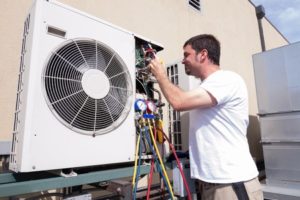
Doing Some Maintenance on a Modern HVAC Unit
What Is HVAC?
HVAC which is an acronym for heating, ventilation, and air conditioning, is the mechanical system that maintains a comfortable indoor air temperature.
This important role means HVAC systems are often used all day, every day without much of a break, especially in climates with intense hot or cold weather. Constant use can lead to problems, especially the following three.
Low Refrigerant
Refrigerant is a chemical which transitions from a liquid to a gas and back again to create a cooling effect. It’s possible for refrigerant to leak and, if the refrigerant level becomes too low, a host of issues besides poor air conditioner performance can result. Low refrigerant will cause your home to feel warmer than it should while your air conditioning works overtime to try to bring the temperature down. Your electricity bills will spike and condensation water will begin to leak out around your furnace. Read More
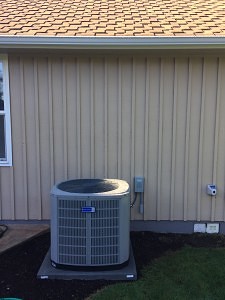
Regular Maintenance Extends the Life of Your Air Conditioner
Creating an HVAC maintenance plan can easily prevent issues and save you a great deal of money and misery.
If you’ve ever suffered through a week or two of chilly winter weather without heat, then you can definitely identify with the importance of keeping an HVAC system in prime condition all year long. HVAC systems are situated away from main rooms, usually in basements or back closets, which places them at risk of being forgotten until a serious problem arises.
Do Routine Maintenance Yourself
Major problems with your HVAC system should always be handled by a professional, but there are simple measures you can take to minimize the chances that a problem will even occur. First of all, make it a priority to change the filters on a regular basis. Dirty filters cause additional wear and tear, premature failure, and forces the use of more energy to do the same amount of work.
- A clean filter dramatically improves indoor air quality. In the depths of winter and height of summer, when the system is getting it’s hardest use, changing your filter once a month is best.
- Try setting your thermostat at more moderate temperatures. Keeping it set higher in the summer and lower in the winter means that your HVAC doesn’t have to work so hard to maintain your desired temperature, thus preventing avoidable wear and tear.
- Make a seasonal to-do list that includes inspecting electrical connections and testing your HVAC system’s voltage, lubricating all moving parts, and inspecting the condensate drain.
When to Call the Experts
If your HVAC is having problems, you can’t handle, don’t wait to call a heating and air conditioning specialist. The longer the problem is left ignored, the worse it is likely to get. Whether it’s a leak, blown fuse, or worn contactor, all issues can be resolved by an HVAC expert so that one problem doesn’t lead to six others that drain your bank account.
